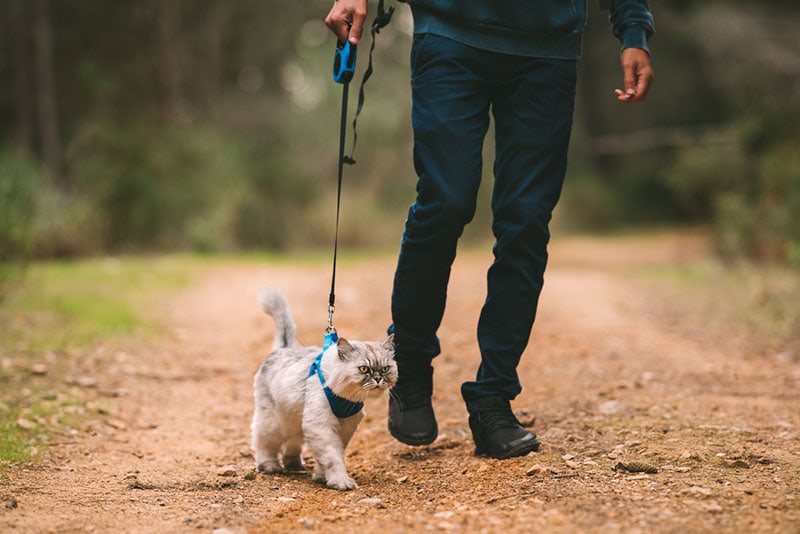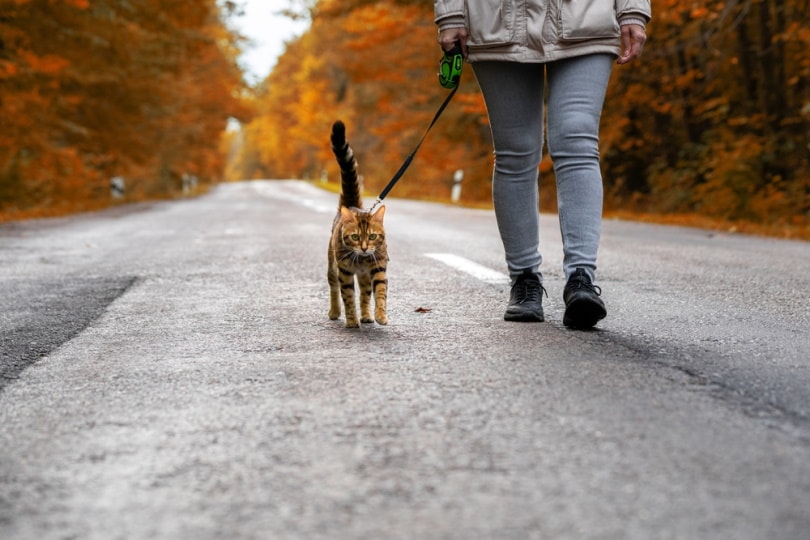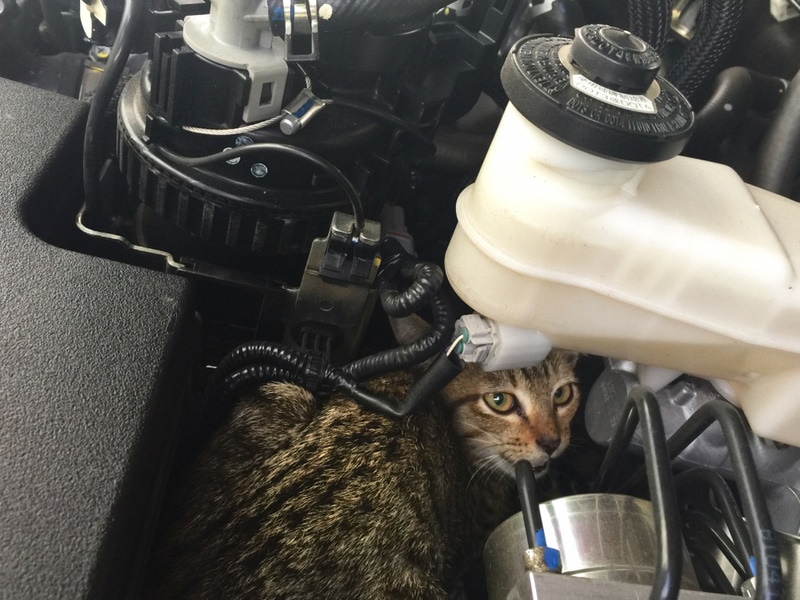How to Hike With Your Cat: 10 Expert Tips
By Ashley Bates
Updated on

Dogs get all the fun! They are always getting to go out on long journeys with their pet parents, and no one bats an eyelash. But when you tell everyone you are taking your feline friend on a hiking journey, you might get some mixed reactions – typically surprise. However, it makes sense that we take cats out on adventures.
After all, they love the great outdoors, and many of them do not live in places where they can explore freely. Preparation is key if you have recently decided it is time to take your cat with you hiking into the great unknown. In this article, we will discuss how to take your cat on hiking adventures safely so they can enjoy!
The 10 Expert Tips on How to Hike With Your Cat
1. Get the Right Hiking Gear
Before anything else, you’ll want to ensure you have all the right gear for successful adventures. This might require a bit of research, and it can be trial and error. After all, some products that work for certain cats might not be the ideal choice for others.
- Harness: You’ll want a well-fitting, quality harness for your cat to go on adventures. Many cats will love to be down running around exploring while you hike. Buying the correct harness that has all of the security features you need is paramount when you are in wide-open spaces. You can find cat harnesses both in pet shops and online. Always take your cat’s exact measurements and check out individual sizing charts to purchase the perfect fit.
- Backpack: Your cat might be unable to keep up for long periods. Having a backpack on hand is super useful. Not only can you carry all of your cat’s essentials, but you can also put them in there when they feel a little tuckered out or need a bit more security.
- Food/Water: Of course, you’ll also need the essentials—food and water! Always make sure you have some, and maybe some yummy snacks, too!
- Food/Water Bowls: You can get any food and water bowls of your choosing. However, it might be best to get collapsible bowls for easy storage.
- Waste Bags: Your cat may need a place to do their business on the trail—and it’s your job to clean it up. You can buy waste bags online or in-store to take on your journey.
- First Aid: You can buy first aid kits on sites like Chewy designed especially for cats. Accidents happen—and you’ll want to be prepared.
Taking your cat for a walk can be rewarding for both of you, but you will need a great harness and leash. Our Hepper Cat Harness & Leash Set is a secure, sturdy option made from lightweight, machine-washable velvet and airy mesh. With multiple adjustment points, reinforced stitching, and reflective stripes, this harness will keep your cat comfortable and safe, and the premium climbing rope leash will make walking a breeze.
2. Carry Your Cat Outside
It might be intuitive to put your cat in a harness and walk them out the door. However, experts will disagree with you in this category. It makes a lot of sense when you think about it.
If your cat is used to just walking out the door, they can do so at very inappropriate times, especially if your cat is indoors 100% of the time. This might be okay if you have an indoor/outdoor cat. But many living situations do not allow cats access to both.
Rather than teaching them they can go out, carry your cat outside – either in a carrier or in your arms. This way, they associate the outing with the method and don’t decide to go out on their own accord.
If your cat thinks they can just waltz out, they might bolt when your kids go out to play or you open the door up for the pizza man.

3. Car Train
Your cat is probably not in the car very often. Occasionally, trips to the vet, groomer, and other necessary places might require a car trip, but they are new to traveling for pleasure. Before you even start going on hikes, you should take your kitty on some pleasure cruises just for fun.
Start small initially, keeping car rides to a few minutes at a time. Let your cat tag along if you are going to the gas station. Remember that you should never leave your cat unattended in the vehicle for any length of time.
Cats are very sensitive to temperature, and it can get toasty hot in the car. If you would not leave a dog in the car, follow suit with your cat as well. If your cat is new to this experience, leaving them unattended in an unfamiliar space might cause a lot more stress.
4. Start Small
Once your kitty has all their necessary gear and they are used to the car, you can go on your first adventure! Whether it’s to a quiet little park down the road or another place you choose, start small and work your way up.
You should keep the first few adventures relatively short, avoiding any lengthy trips. If you start this journey before your cat is acclimated, it can cause some significant stress. So, practice before the big event to get your cat ready.

5. Be Safe
Safety is key when taking your cat out on a journey! You want to make sure that they are comfortable and secure the entire time. If your cat feels vulnerable or there is potential danger lurking around, one bad experience can seriously tip the scales for future adventures.
While taking your cat on trips is terrific, it is hard to tell how other pets will respond. So always ensure you get the safest gear, take your cat to an area matching their experience level, and avoid crowded places.
Since dogs are predominantly chosen to accompany humans on such adventures, you’re bound to bump into one at some point on your journey. Some pups on the trail can be territorial or simply curious about cats. While this might be completely harmless, it can sour quickly depending on the dog in question or your cat’s reaction.
Always be on high alert and ready to intervene if interactions go south.
6. Try Peaceful Spots
All cats respond differently to new stimuli. Some cats will be at home on the trail, not caring who is around them. Others, however, take the more reserved approach. Strangers or other pets might overstimulate them on your outings.
The large open spaces might also intimidate them if they aren’t used to being outside. So, it’s best to start small until you learn how your cat will respond. Visit somewhere that is familiar to you so you can gauge how quiet the location is.
Try a home space, such as a backyard or nearby trail to start.

7. Encourage Exploration
Encourage your cat to sniff around. There will be so many new sights, smells, noises; you name it! Some of them might be very cautious about this new bounty of information, while others will be so excited to scout.
If your cat is feeling a little insecure, give them some reassurance! Let them know that all is well and they are entirely safe to check things out.
8. Pay Attention to Body Language
Body language is very important. It can tell you a lot about your cat’s mental state when you’re out. Try to pay close attention to make sure that your cat is feeling complacent and adventurous.
If they tense up, check out what is around them to gauge what could be causing the reaction. Remove them from the stimuli if needed. You could always put them in the backpack until the situation calms down.
The last thing you will want is for your cat to get frantic and manage to escape unfamiliar territory. If you launch their physical cues, you can alleviate any spooks or stressors.

9. Check the Weather
You won’t want to go out and get caught up in a surprise monsoon when you’re out for the day. Your cat will not appreciate getting drenched, and it might give them a negative experience to reflect on later.
Rain is one of many deterrents for taking your cat on adventures. You must also be careful that the temperatures aren’t too hot, cold, or stormy. Any inclement weather can cause a negative reaction or simply turn it into a crummy experience.
Sunny or overcast days are the best.
10. Accept That Some Cats May Not Be Up for Hiking
Like we have stated a few times now, every cat is different. It is essential to see how your cat responds to hiking and respond accordingly. There is a real possibility that some cats are not cut out for this kind of adventure.
If your cat is skittish, nervous, uncertain, or any other temperament that might cause negative experiences, they might need to stay home, and that’s okay!
Final Thoughts
Hiking with your cat can be such a fun time for the two of you. It can create a bonding experience and serves as a great way to get your kitty out of the house. In this controlled setting, you can safely walk your cat without worrying about them venturing off alone and getting lost.
Granted, proper safety measures and specific accommodations must happen for successful trips. Once your cat gets the hang of it, it’s certainly something they will anticipate—and so will you!
You Might Also Be Interested In:
Featured Image Credit: Creative Cat Studio, Shutterstock












